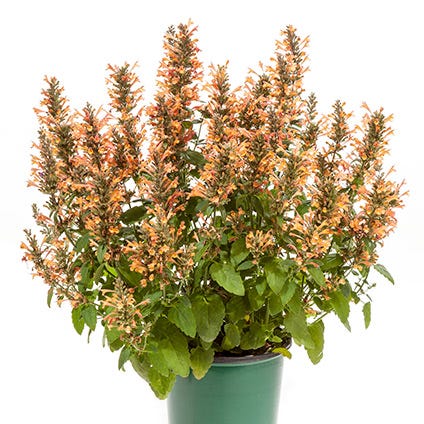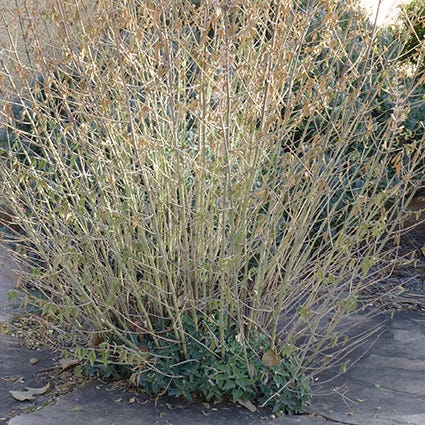The Fabulous Hummingbird Mints - Five New Agastache Varieties
by High Country Gardens

This genus of native plants has held my full attention for more than 20 years. During that time, I have enjoyed growing, breeding and selecting new cultivars here in my Santa Fe, NM gardens. No doubt, my intense interest in these perennials has been helped by the fact that they are very successfully grown in this high desert climate. (This is because many of the native Agastache species are found in my neck of the woods; the Southwestern US and northern Mexico.)

Here are the New Agastache Varieties for Spring 2017:
- Agastache Acapulco® Deluxe Peach - 12-15" tall x 12-15" wide. This is a very compact new hummingbird mint with pretty pastel-pink flowers that attract hummingbirds to your landscape. Use it in container gardens because it's long blooming and makes an excellent annual flower companion.
- Agastache Acapulco® Deluxe Yellow - 12-15" tall x 12-15" wide. This too is a very compact new hummingbird mint with pretty light yellow flowers that attract hummingbirds. Use it in container gardens because it is long blooming and makes an excellent annual flower companion.
- 'Blue Boa' - 30-36" tall x 15-18" wide. Here is a stunning new hybrid variety that blooms for several months from mid- to late summer with showy spikes of deep violet-blue flowers. This perennial is a stiffly upright grower with large green leaves that grows best in fast draining soil and average moisture levels; it's not a xeric species. Leave the stems in place over the winter months to improve cold hardiness. Seedling will not be true-to-type and should be weeded out.
- Agastache foeniculum (Blue Hyssop) - 30-36" tall x 15-18" wide. Native to the northern tier states of the US and Canada, this exceptionally cold hardy Hyssop blooms for many months with smoky-blue to mid-blue flowers held above attractive, aromatic foliage. An outstanding perennial for attracting bees and butterflies with its nectar-rich flowers, is a highly recommended perennial for gardeners in the moister eastern half of the country, and in the northern tier states of the West like Montana and Wyoming. This species is reliably USDA zone 4 cold hardy. Just be sure to give it adequate water in the summer as it's not as xeric as the Southwestern species.
- Agastache rupestris 'Apache Sunset' (Compact Licorice Mint Hummingbird Mint) - 18-24" tall x 15" wide. This is a semi-dwarf selection of this species that is about 1/3 shorter in flower than Glowing Embers® or the original selection of Agastache rupestris. It's seed grown so plants will not be uniform as cutting grown plants like Glowing Embers®.

And as I've talked with High Country Gardens customers over the years, I have come to understand how the Agastache react in regions of the US with different climates than Santa Fe. That's why I like to offer a wide variety of species and cultivars; to give gardeners more plants from which to best match their growing conditions.

Understanding Region Differences When Choosing Agastache For Your Garden
For gardeners in cold winter, higher rainfall areas (especially east of the Mississippi River), plant selection is essential for long term success with these incredible flowering perennials.
- Many of the Southwestern species like Agastache rupestris (Licorice Mint hummingbird mint) and Agastache cana (TX Hummingbird Mint) and their hybrids (Desert Sunrise®, 'Desert Solstice') are not a good match.
- Yet, other species and selections of Agastache, like the Acapulco® group of hybrids, Blue Hyssop (A. foeniculum) and 'Blue Boa' can be better suited to these wetter regions with proper soil preparation, mulching and fertilization.

How To Plant Agastache
Just be sure to plant into fast draining, low humus ("lean") soils in full sun. Mulch with small diameter gravel to protect the crown from winter moisture and only fertilize in the fall with a low nitrogen, high trace mineral fertilizer like Yum Yum Mix. No chemical fertilizers (Miracle Gro or similar higher nitrogen formulations) as these cause the plants to grow like annuals and not be tough enough to make it through winter.
Helpful Hint: Fall Care For Agastache - Improving Cold Hardiness of Hummingbird Mints
It is essential that you not cut back hummingbird mints in the fall. Leave the old stems from last summer's growing season on the plants. Nutrients from the stems help to feed the crown and fortify it against winter cold. Wait until mid-spring in your area (a month or so before last frost) to cut them back. Remove the old stems just above the tuft of green foliage growing from the crown.

Text and Photos by Founder and Chief Horticulturist David Salman.
© All articles are copyrighted by High Country Gardens. Republishing an entire High Country Gardens blog post or article is prohibited without written permission. Please feel free to share a short excerpt with a link back to the article on social media websites, such as Facebook and Pinterest.